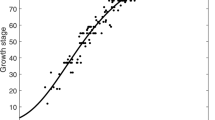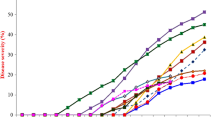Abstract
Wheat blast, caused by the fungus Magnaporthe oryzae Triticum pathotype (MoT), is a serious disease capable of causing severe losses, especially during warm and humid weather conditions. Although the pathogen attacks all aboveground parts, infection of the wheat spikes is of major concern. In this work we developed and evaluated a prediction model based on the analysis of historical epidemics and weather series in the northern Paraná state, Brazil (Apucarana, Maringá and Londrina) and available epidemiological knowledge. The disease and weather datasets (hourly scale) examined encompassed the 2001–2012 period. A specific database management application (agroDb) helped to visualize and identify patterns in weather variables during two major outbreaks (2004 and 2009). Specifically, uncommonly humid and warm weather for most locations during a 60-day period preceding wheat heading during years of major outbreaks were considered key drivers of inoculum build up and airborne spores from regional inoculum sources in the surroundings. An inoculum potential (IP) and a spore cloud (SPOR) variable were estimated from models adapted from literature to predict inoculum build-up and availability. A day favoring infection (DFI) was conditioned to rules relating temperature and relative humidity for the day derived from the epidemic analysis. Successful daily infection (INF) during a DFI was conditioned to IP > 30 and SPOR >0.4. To test the model, a wheat model simulated heading date for 10 planting dates, spaced 5 days apart, within a year, totaling 320 simulations. The model described well epidemic and non-epidemics conditions for the historical dataset, and was able to correctly predict epidemic (2015) and non-epidemic (2016) years not analyzed to build the model. An interactive risk-mapping tool that collects real-time weather data was developed for the target area to warn potential outbreaks.The system can be adapted to other regions where the disease is endemic or to asses the epidemic potential in regions where the disease is not present.





Similar content being viewed by others
References
Alves KJP, Fernandes JMC (2006) Influência da temperatura e da umidade relativa do ar na esporulação de Magnaporthe grisea em trigo. Fitopatol Bras 31:579–584
Bregaglio S, Donatelli M (2015) A set of software components for the simulation of plant airborne diseases. Environ Model Softw 72:426–444
Caierão E, Pasinato A, Harger N, Maurina AC, Pires JLF, Pimentel, MBM (2009) Uso de tecnologias em lavouras de trigo tecnicamente assistidas no Paraná - safra 2008. Embrapa Trigo, Documentos Online 111. Available at: www.cnpt.embrapa.br/biblio/do/p_do111.htm
Caierão E, Pasinato A, Harger N, Maurina AC, Pires JLF, Pimentel, MBM (2010) Uso de tecnologias em lavouras de trigo no Paraná - safra 2009. In: Pires JLF, Pasinato A, Caierão E, Tibola CS. Trigo: resultados de pesquisa - safra 2009. Embrapa Trigo, Documentos Online 96. Available at: http://ainfo.cnptia.embrapa.br/digital/bitstream/item/128920/1/ID41962-2010-LVdocumentos96-p135-154.pdf
Calvero SB Jr, Coakley SM, Teng PS (1996) Development of empirical forecasting models for rice blast based on weather factors. Plant Pathol 45:667–678
Cardoso CAA, Reis EM, Moreira EN (2008) Development of a warning system for wheat blast caused by Pyricularia grisea. Summa Phytopathol 34:216–221
Castroagudín L, Moreira SI, Pereira DAS, Moreira SS, Brunner PC, Maciel JLN, Crous PW, McDonald BA, Alves E, Ceresini PC (2016) Pyricularia graminis-tritici, a new Pyricularia species causing wheat blast. Persoonia 37:199–216
Chang W, Cheng J, Allaire JJ, Xie Y, McPherson J (2017) Shiny: web application framework for R. Available at: https://CRAN.R-project.org/package=shiny
Cruz, CD and Valent, B (2017) Wheat blast disease: danger on the move. Trop Plant Pathol. doi:10.1007/s40858-017-0159-z
Cruz, C. D., Magarey, R. D., Christie, D. N., Fowler, G. A., Fernandes, J. M., Bockus, W. W., Valent, B., and Stack, J. P. 2016. Climate suitability for Magnaporthe oryzae Triticum pathotype in the United States. Plant Dis. 100:1979–1987
da Silva GB, Prabhu AS (2005) Quantificação de Conídios de Pyricularia grisea no plantio direto e convencional de arroz de terras altas. Fitopatol Bras 30:569–573
De Mori C, Ignaczk JC, Maurina AC, Ferreira FA (2008) Uso de tecnologias nas lavouras de trigo tecnicamente assistidas do Estado do Paraná, Safra 2007. Available at: http://ainfo.cnptia.embrapa.br/digital/bitstream/item/130215/1/ID43227-2008reuniaotrigo-CD-192transf8.pdf
De Mori C, Harger N, Foloni JSS, Eichelberger L, Bassoi MC, Dossa AA, de Oliveira AB, Bodnar A, Fae GS, Tavares LCV, Cesa P (2014) Uso de tecnologias em lavouras de trigo tecnicamente assistidas no Paraná - safra 2012. Embrapa Trigo, Documentos Online 148. Available at: http://ainfo.cnptia.embrapa.br/digital/bitstream/item/103757/1/2014-documentos-online148.pdf
Deacon, J (2005) Fungal spores, spore dormancy, and spore dispersal, in fungal biology, 4th edition, Blackwell doi:10.1002/9781118685068.ch10
Farman M, Peterson GL, Chen L, Starnes JH, Valent B, Bachi MP, Murdock L, Hershman DE, Pedley KF, Fernandes JMC, Bavaresco J (2017) The Lolium pathotype of Magnaporthe oryzae recovered from a single blasted wheat plant in the United States. Plant Dis 101:684–692
Framework for effects mediated by plant disease. Plant Pathol 60:15–30
Goulart ACP, Sousa PG, Urashima AS (2007) Danos em trigo causados pela infecção de Pyricularia grisea. Summa Phytopathol 33:358–363
Harger N, Bodnar A, Pasinato A, Caierao E, Pires JLF, Pimentel, MBM (2011) Uso de tecnologias em lavouras de trigo no Paraná, Safra 2010. In: 5ª Reunião da Comissão Brasileira de Pesquisa de Trigo e Triticale, Ata e resumos... Dourados: MS. Embrapa Agropecuária Oeste. Available at: http://www.alice.cnptia.embrapa.br/handle/doc/1024089
Harmon PF, Latin R (2005) Winter survival of the perennial ryegrass pathogen Magnaporthe Oryzae in north Central Indiana. Plant Dis 89:412–418
Igarashi S, Utiamada C, Igarashi L, Kazuma A, Lopes R (1986) Pyricularia em trigo. 1. Ocorrência de Pyricularia sp. no estado do Paraná. Fitopatol Bras 11:351
Ignaczk JC, Maurina AC, De Mori C & Ferreira FA (2005) Uso de tecnologias em lavouras de trigo tecnicamente assistidas no Paraná – safra 2004. Embrapa Trigo, Documentos Online 51. Available at: http://www.cnpt.embrapa.br/biblio/do/p_do51.htm
Ignaczk JC, Maurina AC, De Mori C, Ferreira FA (2006) Uso de tecnologias em lavouras de trigo tecnicamente assistidas no Paraná – safra 2005. Embrapa Trigo. Available at: http://www.infoteca.cnptia.embrapa.br/handle/doc/852105
Ignaczk JC, Maurina AC, De Mori C, Ferreira FA (2007). Uso de tecnologias em lavouras de trigo tecnicamente assistidas no Paraná - safra 2006. Embrapa Trigo, Documentos Online 86. Available at: http://www.cnpt.embrapa.br/biblio/do/p_do86.htm. Accessed on January 10, 2017
Kim KR (2000) Weather-driven models for rice leaf blast and their implementation to forecast disease development on the near real-time basis. PhD Thesis, Seoul National University, Suwon
Kim KS, Lee Y-H, Murillo J (2012) Gene expression profiling during conidiation in the rice blast pathogen Magnaporthe Oryzae. PLoS One 7:e43202
Kohli MM, Mehta YR, Guzman L, Viedma LD, Cubilla LE (2011) Pyricularia blast - a threat to wheat cultivation. Czech J Genet Plant Breed 47:S130–S134
Lazzaretti AT, Fernandes JMC, Pavan W (2015) Calibração do cropsim-wheat para simulação do desenvolvimento e rendimento de grão de trigo no Sul do Brasil. Agrária 10:356–364
Lazzaretti AT, Fernandes JMC, Pavan W, Toebe J, Wiest R (2016) AgroDB - integration of database management systems with crop models. In: 8th international congress on environmental modelling and software, proceedings… Toulouse, France. iEMSs p. 194-201
Lee K, Singh P, Chung W-C, Ash J, Kim TS, Lisa H, Park S (2006) Light regulation of asexual development in the rice blast fungus, Magnaporthe Oryzae. Fungal Genet Biol 43:694–706
Li Y, Uddin W, Kaminski JE, Dufault NS (2013) Seasonal and daily patterns of Magnaporthe oryzae conidia availability in gray leaf spot-perennial ryegrass pathosystem. In: American Phytopathological society meeting, abstracts… Austin, TX, USA
Li Y, Uddin W, Kaminski JE (2014) Effects of relative humidity on infection, colonization and conidiation of Magnaporthe orzyae on perennial ryegrass. Plant Pathol 63:590–597
Lucas P (2006) Diseases caused by soil-borne pathogens. In: Cooke BM, Jones DG, Kaye B, eds. The epidemiology of plant diseases, 2nd ed. Dordrecht, the Netherlands: Springer, 373-86
Marangoni MS, Nunes MP, Fonseca N Jr, Mehta YR (2013) Pyricularia blast on white oats: a new threat to wheat cultivation. Trop Plant Pathol 38:198–202
R Core Team (2017) R: a language and environment for statistical computing. R foundation for statistical computing. Available at: https://www.R-project.org/
Reynolds MP, Braun HJ, Pietragalla J, Ortiz R (2007) Challenges to international wheat breeding. Euphytica 157:281–285
Santana FM, Maciel JLN, Lau D, Seixas CDS, Bassoi MC, Goulart ACP, Sussel AAB, Schipanski CA, Montecelli TDN, Chagas JH, Guizeline J (2013) Eficiência de fungicidas para o controle da brusone do trigo: resultados dos ensaios cooperativos - safra 2011. Embrapa Trigo, Comunicado técnico Online 328. Available at: http://ainfo.cnptia.embrapa.br/digital/bitstream/item/103711/1/2013-comunicado-tecnico-online328.pdf. Accessed on January 10, 2017
Suffert F, Sache I, Lannou C (2011) Early stages of septoria tritici blotch epidemics of winter wheat: build-up, overseasoning, and release of primary inoculum. Plant Pathol 60:166–177
Urashima A, Martins T, Bueno C, Favaro D, Arruda M, Mehta Y (2004) Triticale and barley: new hosts of Magnaporthe grisea in São Paulo, Brazil - relationship with blast of rice and wheat. In: Kawasaki S (ed) Rice blast: interaction with rice and control. Netherlands. Springer, Dordrecht, pp 251–260
Acknowledgements
The authors are thankful to the editor and to anonymous reviewers for their comments and suggestions. This work was partially supported by Agriculture and Food Research Initiative Competitive Grant no. 2013-68004-20378 from the United States Department of Agriculture National Institute of Food and Agriculture (USDA- NIFA) and by the CNPq Grant no. 444047/2014-0.
Author information
Authors and Affiliations
Corresponding author
Additional information
Section Editor: Emerson M. Del Ponte
Rights and permissions
About this article
Cite this article
Fernandes, J.M.C., Nicolau, M., Pavan, W. et al. A weather-based model for predicting early season inoculum build-up and spike infection by the wheat blast pathogen. Trop. plant pathol. 42, 230–237 (2017). https://doi.org/10.1007/s40858-017-0164-2
Received:
Accepted:
Published:
Issue Date:
DOI: https://doi.org/10.1007/s40858-017-0164-2




